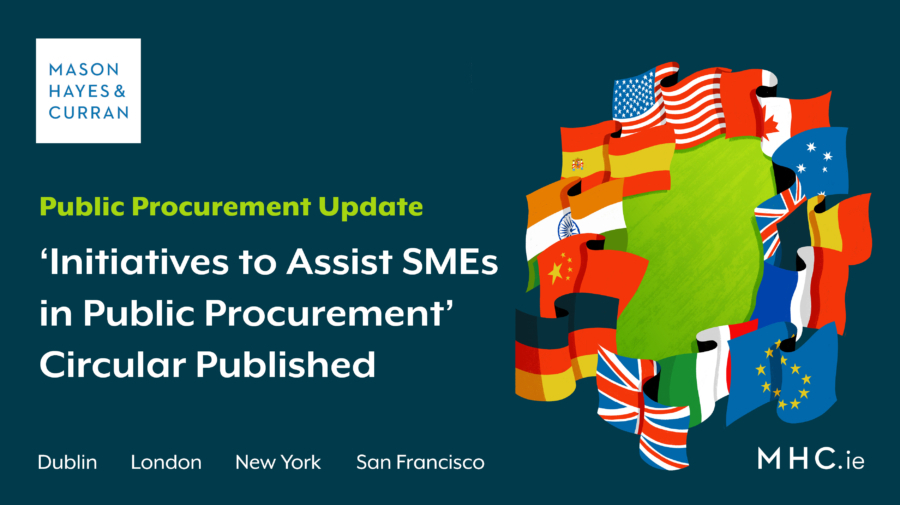‘Initiatives to Assist SMEs in Public Procurement’ Circular Published

Procurement partner, Dorit McCann reviews an important new circular issued by the Department of Public Expenditure, NDP Delivery and Reform to all public sector bodies on ‘Initiatives to Assist SMEs in Public Procurement’. The key change introduced by the Circular is an increase in the thresholds above which public bodies have to advertise public contracts on eTenders. It also contains measures to promote SME participation, most notably guidance on insurance requirements.
The Department of Public Expenditure, NDP Delivery and Reform has issued an important new circular applicable to all public sector bodies on ‘Initiatives to Assist SMEs in Public Procurement’. The key change introduced by the Circular is an increase in the thresholds above which public bodies have to advertise public contracts on eTenders. It also contains measures to promote SME participation, most notably guidance on insurance requirements.
The Department of Public Expenditure, NDP Delivery and Reform recently published Circular 05/2023 entitled ‘Initiatives to Assist SMEs in Public Procurement’. The new circular replaces Circular 10/2014 and applies to all public sector bodies from the date of its publication.
Increase in thresholds
The Circular increases the thresholds above which public bodies have to advertise public contracts on eTenders from:
- €25k to 50k (excl VAT) for goods and services
- €50k to €200k for works contracts
There is no change in the thresholds for works-related services.
The following table summarises the current thresholds and the different advertising requirements and applicable procurement procedures:
Contract Type | Estimated Value of Procurement (excl VAT) | Advertising Requirements/ Procurement Procedure |
Goods and services* | <€5k | Verbal or written quotes from one or more suppliers |
€5-50k | At least 3 written quotes, e.g. response to written specifications or via electronic request for quotes facility on eTenders | |
€50 – EU threshold (€215k/€140k for central government authorities) | Formal tendering process via eTenders | |
≥EU threshold (€215k/€140k for central government authorities) | Formal tendering process via eTenders/Official Journal of EU (OJEU) | |
Works-related services | <€50k | Minimum of 5 written tenders |
≥€50k – EU threshold (€215k/€140k for central government authorities) | Formal tendering process via eTenders | |
≥EU threshold (€215k/€140k for central government authorities) | Formal tendering process via eTenders/OJEU | |
Works | <€200k | Minimum of 5 written tenders |
€200k – EU threshold (€5,382,000) | Formal tendering process via eTenders | |
≥EU threshold (€5,382,000) | Formal tendering process via Tenders/OJEU |
*Note: Government departments and offices must continue to report contracts above €25k awarded without a competitive process to the Comptroller and Auditor General in accordance with Circular 40/2002.
In addition, contracting authorities are required to publish contract award notices for all procurements over €25k (excl VAT). This includes any contract awarded under a Framework Agreement, on the eTenders website, whether the procurement was advertised on eTenders or not. For contracts below the relevant EU threshold, a separate notice on eTenders should be created. This new requirement will apply to all procurements, regardless of the contract type, and is a significant additional step for contracting authorities. The publication of award notices for contracts below the EU threshold is intended to facilitate measurement of the impact of the change in thresholds on Small and Medium sized Enterprises (SME) participation in tenders.
Measures to promote SME participation
In addition to the increase in thresholds, the Circular sets out a number of measures to promote participation of SMEs in procurement processes. Many of these were already included Circular 10/2014 but it is worth noting the following:
Preliminary Market Consultations: The Circular highlights the use of market consultations to get a better understanding of the goods and services available and the competitive landscape. It clarifies that consultations can take place directly one-to-one or via a request for information on eTenders and can include engagement with employees, clients, experts and/or policy leads. However, some safeguards must be put in place to prevent consultations from having the effect of distorting competition. For example, information provided during the process should be made available to tenderers and contracting authorities should maintain appropriate records of any engagement with the market.
Turnover Requirements: The Circular reminds authorities that the use of high turnover levels as a measure of financial capacity may provide a barrier to the participation of SMEs. Any turnover or financial capacity requirement must be proportionate to the level of risk involved. In addition, the minimum yearly turnover should not exceed twice the estimated contract value except in properly justified cases. Where a higher turnover requirement is adopted in above EU threshold procurements, this must be justified in the procurement documents or the Regulation 84 Report. The Circular also notes that asset to liability ratios can provide alternative, and sometimes more appropriate, means of assessing financial capacity.
Innovation: The Circular highlights the use of market consultations as a tool to provide insights about the capacity of the market to deliver on the requirements of the authority, the risks involved and to identify creative solutions. It also asks contracting authorities to consider allowing variants to specifications to promote innovative solutions or to set out requirements in terms of a deliverable to allow tenderers to provide creative and innovative solutions, including the implementation of green considerations.
Life-Cycle Costing: The Circular reminds contracting authorities that they should, where relevant, consider not just acquisition costs but the whole life-cycle costs. This can include costs borne by the authority or other users and costs imputed to environmental externalities linked to the product, service or works during its life cycle, provided their monetary value can be determined and verified. Where appropriate, authorities should seek full life-cycle costing solutions in their tender documents.
Insurance: For the procurement of routine low to medium risk goods and services, Appendix 1 of the Circular sets out a guide to assessing insurance level requirements. The recommendations are set out below and remain largely unchanged from the previous circular:
Type of Insurance | Minimum Indemnity Limit |
Employer’s Liability | €12.7 million any one claim or series of claims arising out of a single occurrence |
Public Liability | €6.5 million any one claim or series of claims arising out of a single occurrence |
Product Liability | €6.5 million any one occurrence and in the aggregate per insurance year |
Professional Indemnity | Risk assess based on potential damage and/or loss |
Cyber Insurance | Risk assess based on potential damage and/or loss |
Notably, cyber insurance has been included and further guidance has been provided on the selection of insurance and limits. The Circular also refers to the 2022 Guidance on Indemnity and Insurance from the State Claims Agency which should be of some assistance to authorities. On a practical level, the Circular reminds authorities that they should check the following insurance details:
- Scope/business description
- Name of insured
- Renewal date
- Limit of indemnity
- Territorial limits and jurisdiction
- Insurer authorisation
- Excess and inner limits
- Restrictions/conditions/warranties
- Sub-contractors and indemnity to principals clause (employers, public and product liability policies)
Dynamic Purchasing Systems: The Circular, for the first time, reminds authorities of the potential use of dynamic purchasing system for the procurement of commonly used goods, works or services which are generally available on the market. Dynamic purchasing systems are similar to framework agreements with the key difference being that new economic operators can be admitted throughout their duration.
Comment
The increase in the financial thresholds is welcome as the previous levels were very low, particularly in light of recent inflation levels, and placed a great burden on public bodies. The additional guidance on insurance levels is also welcomed to guide contracting authorities and hopefully avoid overly restrictive levels being set which may exclude many SMEs from procurement processes. A notable addition to the Circular has been the mention of dynamic purchasing systems which are only infrequently used in Ireland. They are a very useful tool which authorities should consider as an alternative to framework agreements.
We have experience of designing and implementing dynamic purchasing systems and would be delighted to assist you. For more information, please contact a member of our Public Procurement team.
The content of this article is provided for information purposes only and does not constitute legal or other advice.
Share this:


